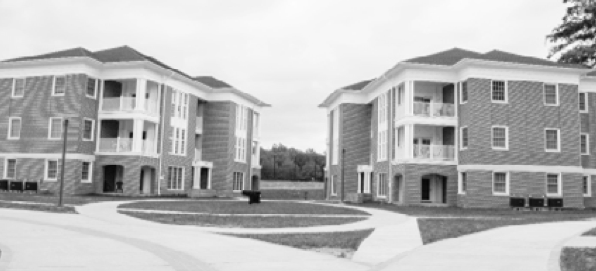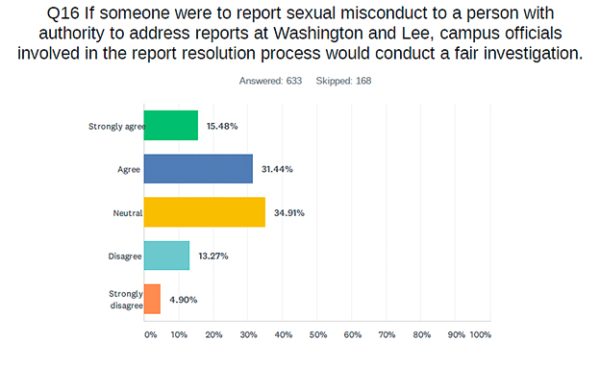Local landlords wary of future of student real estate market
As the second year of “The Village” comes to a close, Lexington landlords are still adapting to the reduction in tenants and worry about the possibility of mandatory on-campus senior housing

April 30, 2018
Since construction was completed on Washington and Lee University’s Third Year Housing Village in 2016, the required housing complex for juniors has halved the potential renters population for Lexington landlords.
“There aren’t enough students to go around anymore,” owner of H and K Properties Heather Hamilton said.
The Village accommodates 338 students, according to David Leonard, dean of student life at Washington and Lee. This is the majority of the junior class. The remaining students live in the school’s Woods Creek apartment complex, followed by Greek Housing and themed housing, Leonard said.
Landlords have cut rental rates and renovated properties to stay competitive. Some have flipped their houses to short-term rentals or put them on the buying market. Others have gotten out of the business all together.
But landlords aren’t the only ones affected by Third Year Housing. Others say the broader Lexington economy has taken a hit.
“I look out of my window every day and there is significantly less foot traffic,” Hamilton said. “That means students are staying on campus and spending their money there, instead of in town.”
Mary Page Welch, ‘18, agrees with Hamilton. She said she spends much more money downtown now that she lives off campus. When she drives through town on her way to school every day, it’s easy for her to park her car and get a meal to go. When Welch lived in Third Year, she said she rarely walked all the way to town for a meal.
But others see an opposite trend.
“Third-year students are now close to campus, which means that they’re closer to downtown,” Will Moore, president of James Moore Real Estate, said.
When students live off campus, it keeps them away from downtown. They are deterred from spending their money at the restaurants and shops on Main Street, Moore said.
In the past, most students lived off campus in the same house for both their junior and senior years. But with Third Year Housing, this is no longer the case.
“In the past, a landlord would sign a lease for two years instead of one,” Moore said. “Now that’s not even the case. It’s one year, so it’s more work for the landlords to find students to get these leases signed,” he said.
Landlords like Don Wilkins are scrambling to find students to fill their homes.
“Two out of my three houses are empty,” Wilkins said. “So that gives you an idea of what Third Year has done to me.”
Wilkins owns three properties off of Greenhouse Road—one of the most popular areas for student housing—often referred to as ‘the country.’ Wilkins lives outside of Philadelphia and has been involved in commercial real estate all his life. He started buying properties in Lexington when his daughters attended W&L in the early 2000s. When his oldest daughter was looking for her first off-campus house, Wilkins came to Lexington to see the property.
“It was just horrible,” he said. “It looked like a meth lab.”
That’s when Wilkins decided to start sprucing up student rentals himself. By most standards, Wilkins is a good landlord. He has completely remodeled all of his properties. He sets up cable and Internet for his tenants. He has a superintendent who lives in Lexington to check the air filters, keep the lawn mowed and pick up the trash. He is the only landlord on the Campus Community Coalition, a W&L student-
run group, which seeks to better relations with the Lexington community. But, he still cannot keep his properties filled.
“I never had a problem here before,” Wilkins said. “People would fight over these places.”
But because of the Third Year Village, Wilkins has had empty homes.
“That strangles me,” he said.
Wilkins still has to keep the heater on, pay his superintendent and other bills while the homes are empty,
“It’s like the hole in the bucket,” he said.
To become more attractive to renters, Wilkins has cut his rent by 15 to 20 percent. It seems to have worked. Now, Wilkins has two of his three properties filled for the upcoming academic year.
But with one property still vacant and the uncertainty of the years to come, Wilkins admitted he’s thought about getting out of the business.
The problem is, the properties aren’t worth the money he put into them years ago. Wilkins said he’s lost 60 percent of the value on his properties—and he is not alone.
“Landlords are in a tight spot,” Moore said. “They don’t have the cash flow that they need, and now the property isn’t worth what they paid for it.”
According to a report by the Federal Reserve Bank of Richmond, the median home sale price increased by 3.33 percent across Virginia over the last year. But this is hard to track for homes in Lexington. There are no reports on the housing market in Lexington.
Moore said home sales are picking up in Lexington and that “[he] is busier than [he] has ever been in real estate.” But he is not a landlord.
“Properties that were bought with the sole purpose of being student houses—those with a high number of bedrooms and proximity to campus—those owners are finding it difficult to adapt to this change,” Moore said.
Wilkins built these homes to be student rentals. He added modular units and bathrooms to transition the properties from single-family homes to high capacity student houses. The properties sit on a hill next to the SPCA across the street from Windfall Hill, a main location for student parties.
Wilkins’ properties cannot go back to being single-family homes. If he wants to sell, other landlords in town or parents like himself are his only potential investors.
To stay afloat, some landlords have transitioned their properties to short term rentals. Students rented the four cabins on Midland Trace year after year. Now, they’re listed as vacation rentals with rates starting at $554 a night.
Other landlords have given up on renting completely and put their properties on the market for sale.
“I’ve had people come to me and say listen, this rental situation has really changed for me,” Moore said.
The returns just aren’t there anymore, so they decide to try selling, he said.
One property, at 427 West Nelson St., which students called “Hobes,” was traditionally a student rental. It’s been rented to a single family since the Third Year Village was built. But as of the first week of April, it’s on the market for sale.
While the school has issued no formal statement saying it plans to build a Fourth Year Housing Village, it’s something everyone in the real estate business has on their minds. If W&L forces students to live on campus all four years, “it’s pretty clear that all those properties will go vacant,” Moore said.
If that happens, “Senior housing is going to be an issue for Lexington,” Hamilton said.
This story was has been adapted from original reporting completed during winter term as part of JOUR372: Reporting on the Economy.












